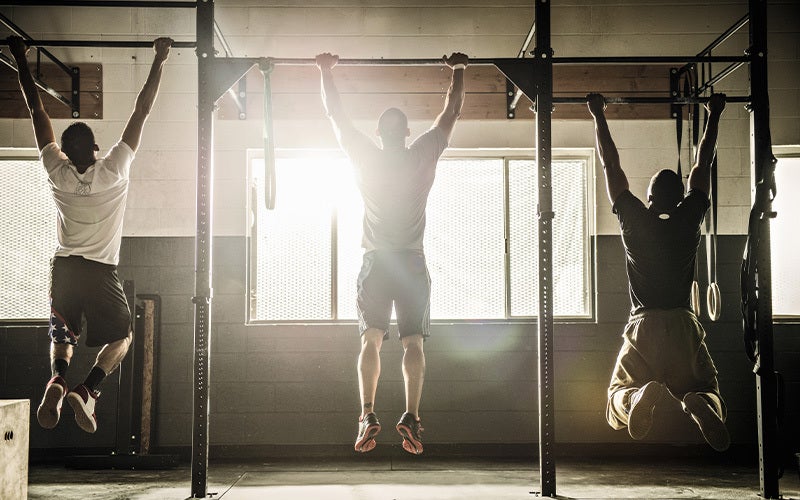6 Moves to Get You to Pull-ups
 ©Corey Jenkins
©Corey Jenkins
Pull-ups are the essential bodyweight exercise for your back. But many athletes — even pros — can’t eke out a rep. No matter how much upper body strength you have now, with enough time and effort, you, too, can get your chin above the bar. Here’s how.
What’s the basis of pull-up training?
There are three tentpoles to keep in mind.
- Frequency
To learn a new movement, you need to work on it regularly. Three or four times a week is a good guideline. Some of that time will be spent on the bar, but if your initial goal is building up the back and shoulder strength to perform the move, expect that most of your workouts will be on the floor. Related back exercises, focusing on your lats, for example, should be part of all strength workouts for beginners: rows, kneeling pull-downs, and ring rows help improve coordination and build up the strength to get to your first pull-up.
Already able to do a few reps of the move? These moves will help you gain strength to bust out a few more, and there are plenty of variations to up the challenge.
- Progression
No matter where you are in your pull-up journey, there’s always room for gaining strength and capacity. Are 2 sets of 4 reps of assisted pull-ups starting to get easy? Great! Time to step it up. Are unassisted pull-ups in your repertoire and you want to take it to the next level?
- Recovery
Big goals that push your limit take commensurate effort. But if you notice you’re plateauing or backsliding, you probably need a break. Take a few days off training entirely, or workouts that are less intense on your pull-up muscles: think cycling, swimming, and hiking.
Related: 5 reasons why you should definitely go hiking
The workout
These exercises will help you practice supporting your own weight while also strengthening your core, which is also essential for pull-ups. Do these moves 2 to 4 times per week. After a month, test your pull-ups. If you’re not quite there yet, work on negative pull-ups. Place a box under a pull-up bar, and jump up on the bar to start at the top of a pull-up, then lower yourself as slowly as you can.
Refuel: Try our whey protein powder
- Slow motion mountain climbers
| Difficulty: | Easy-medium |
| Muscles worked: | Core, shoulders, back, arms, chest |
| Tips: | Pull your knee as close to your chest as possible. Spread your fingers wide, place hands under shoulders, and press into the palms of your hands to create more space between your chest and the floor. Keep elbows straight but soft. The body should feel like it’s constantly under tension, as if the heel of your back leg is pressed against a wall. |
| Variations: | To make it easier, go through the mountain climbers more quickly. To make it harder, hold the position for longer and pull your knees up higher. |
- Bar row
| Difficulty: | Medium-difficult |
| Muscles worked: | Back, arms |
| Tips: | Activate your core muscles. Keep your shoulder blades back and down. Your whole back, including lumbar spine, stays straight. Stand with weight evenly distributed in your feet. |
| Variations: | To make it easier, reduce the weight of the barbell, or use dumbbells. To make it harder, increase the weight on the barbell, or use kettlebells. |
- Ring Rows
| Difficulty: | Hard |
| Muscles worked: | Arms, back, core |
| Tips: | Keep hands shoulder-width apart. Tense your abdomen and legs, heels resting on floor. Your whole body should be straight, like you’re maintaining a plank. Start with 2 sets of 6 to 8 reps. |
| Variations: | To make it easier, start with your body further back (more vertical) so your chest isn’t directly under the rings. To make it harder, place feet further forward, bringing the body more horizontal to the floor. |
- Hanging knee lifts
| Difficulty: | Medium |
| Muscles worked: | Arms, core, back |
| Tips: | In the hang position, keep elbows slightly bent. Pull your body up a little toward the bar. |
| Variations: | To make it easier, pull up one knee at a time. To make it harder, raise both knees to knee level, then extend one leg and hold briefly; switch sides. Still too easy? Lift both legs as far as you can, or hook light kettlebells to feet. |
- Kneeling pull-downs
| Difficulty: | Medium |
| Muscles worked: | Back, arms |
| Tips: | Keep your neck long and look straight ahead. Keep tension in your core to avoid hollowing out your back. |
| Variations: | To adjust the difficulty, use a thinner or thicker resistance band. You can also double them up. |
- Supported pull-ups
| Difficulty: | Hard |
| Muscles worked: | Back, arms |
| Tips: | Choose the amount of assistance you need to do 2 sets of 3-4 reps. Place the band under the middle of your foot or under a knee. Then grab the bar and let yourself sink down slowly. Grab the bar with your palms facing you to work on a chin-up. |
| Variations: | To adjust the difficulty, use a thinner or thicker resistance band. You can also double them up. |
More healthy living tips from foodspring:
- Weight Loss Workout Plan: What you need to know
- How to Lose Weight with Yoga
- How to lose weight without dieting: 13 tips to your feel-good body
- Create your ideal weight loss meal plan and work towards your feel-good body!
- Weight Lifting For Weight Loss
Sources for this article
We at foodspring use only high-quality sources, including peer-reviewed studies, to support the facts within our articles. Read our editorial policy to learn more about how we fact-check and keep our content accurate, reliable, and trustworthy.





























